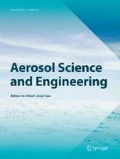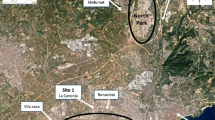Abstract
The study was initiated to determinants of inhalation exposure to polycyclic aromatic hydrocarbon compounds (PAHs) among iron foundry workers in different workplace namely, molding, melting, shaking, blasting and finishing sections. The study population included five sections of foundry workers: 22 molding, 25 melting, 20 shaking, 18 blasting and 15 finishing workers. During work shifts, personal air samples were collected from each worker’s breathing zone using a PTFE filter and cassette holder connected in series with an XAD-2 sorbent tube. The entire sample were analysed for sixteen PAHs with HPLC. The total inhalation exposure of total PAHs (ΣPAHs) concentrations was 46.64 μg/m3 ranging 0.08–478.43 μg/m3 in all the samples. The PAHs with lower molecular weight and higher molecular weight contributed 55.02% and 44.98%, respectively, to the ΣPAHs. About 16% exposure samples collected at various sections of foundry exceeded the PAHs level prescribed by NIOSH standard limit. The highest level of ΣPAHs were found in the molding (82.64 μg/m3) followed by finishing (67.86 μg/m3), blasting (34.74 μg/m3), shaking (25.04 μg/m3) and melting (23.48 μg/m3) sections, respectively. By applying risk assessment it was estimated that the total unit risk of PAHs harming the foundry workers was 9.43 × 10–4 and about 95% of total risk is contributed by benzo[α]pyrene (BaP) and dibenzo [α h]anthracene (DahA). The study indicating the inhalation risk due to these PAHs exposures are not negligible and should be taken into account for health protection of the workers to address the quantitative aspects relating lung cancer risks to PAHs compounds in foundries.


Similar content being viewed by others
References
Agency for Toxic Substances and Disease Registry (2013) Toxicological profile for polycyclic aromatic hydrocarbons. Atlanta Website. https://www.atsdr.cdc.gov/toxprofiles/tp69.pdf. Accessed 21 January 2016
Armstrong B, Tremblay C, Baris D et al (1994) Lung cancer mortality and polynuclear aromatic hydrocarbons: a case-cohort study of aluminum production workers in Arvida, Quebec, Canada. Am J Epidemiol 139(1):250–262. https://doi.org/10.1093/oxfordjournals.aje.a116992
Brandt HC, Watson WP (2003) Monitoring human occupational and environmental exposures to polycyclic aromatic compounds. Ann Occup Hyg 47(5):349–378
Carol KR, Barbara RS, Raymond HC (1976) Cancer experience among coke by-product workers. Ann N Y Acad Sci 271:102–115. https://doi.org/10.1111/j.1749-6632.1976.tb23099.x
Carstensen U, Yang K, Levin JO (1999) Genotoxic exposures of potroom workers. Scand J Work Environ Health 25(1):24–32
Chen HL, Lin MH, Chen CJ, Liu HH (2011) Assessments of PAHs exposure and health effects for Foundry’s workers. Epidemiology 22(1):S231–S232. https://doi.org/10.1097/01.ede.0000392398.82030.f0
Gaertner RR, Theriault GP (2002) Risk of bladder cancer in foundry workers: a meta-analysis. Occup Environ Med 59:655–663
Gibson ES, Martin RH, Lockington JN (1977) Lung cancer mortality in a steel foundry. J Occup Med 19:807–812
Hansen AM, Omland O, Poulsen OM (1994) Correlation between work process-related exposure to polycyclic aromatic hydrocarbons and urinary levels of a-naphthol, lB-naphthylamine and 1-hydroxypyrene in iron foundry workers. Int Arch Occup Environ Health 65:385–394
Hansen AM, Mathiesen L, Pedersen M et al (2008) Urinary 1- hydroxypyrene (1-HP) in environmental and occupational studies—a review. Int J Hyg Environ Health 211:471–503. https://doi.org/10.1016/j.ijheh.2007.09.012
Hu Y, Zhipeng B, Zhang L et al (2007) Health risk assessment for traffic policemen exposed to polycyclic aromatic hydrocarbons (PAHs) in Tianjin, China. Sci Total Environ 382:240–250. https://doi.org/10.1016/j.scitotenv.2007.04.038
International Agency for Research on Cancer (1983) Polynuclear aromatic compounds: Part 1, chemical, environmental and experimental data. IARC Monograph Vol. 32, Lyon. https://monographs.iarc.fr/ENG/Monographs/vol1-42/mono32.pdf. Accessed 05 September 2011
Kalina I, Brezani P, Gajdosova D et al (1998) Cytogenetic monitoring in coke oven workers. Mutat Res 417:9–17
Knecht U, Elliehausen HJ, Woitowitz HJ (1986) Gaseous and adsorbed PAH in an iron foundry. Br J Ind Med 43:834–838
Kuo CY, Cheng YW, Chen YW et al (1998) Correlation between the amounts of polycyclic aromatic hydrocarbons and mutagenicity of airborne particulate samples from Taichung City, Taiwan. Environ Res 78(1):43–49. https://doi.org/10.1006/enrs.1998.3838
Kuo CY, Chang SH, Chien YC, Chiang FY et al (2006) Exposure to carcinogenic PAHs for the vendors of broiled food. J Exp Sci Environ Epidemiology 16(5):410–416. https://doi.org/10.1038/sj.jea.7500466
Law RJ, Kelly C, Baker K et al (2002) Toxic equivalency factors for PAH and their applicability in shellfish pollution monitoring studies. J Environ Monit 4:383–388
Lewtas J, Walsh D, Williams R, Dobias L (1997) Air pollution exposure–DNA adduct dosimetry in humans and rodents: evidence for non-linearity at high doses. Mutat Res 378:51–63
Lin YC, Lee WJ, Chen SJ et al (2008) Characterization of PAHs exposure in workplace atmospheres of a sinter plant and health-risk assessment for sintering workers. J Hazard Mater 158:636–643. https://doi.org/10.1016/j.jhazmat.2008.02.006
Menzie CA, Potocki BB, Santodonato J (1992) Exposure to carcinogenic PAHs in the environment. Environ Sci Technol 26:1278–1284. https://doi.org/10.1021/es00031a002
NIOSH (1998) Polycyclic aromatic hydrocarbons by HPLC: method 5506. NIOSH manual of analytical methods, 4th edn. NIOSH, Cincinnati
Nisbet ICT, LaGoy PK (1992) Toxic equivalency factors (TEFs) for polycyclic aromatic hydrocarbons (PAHs). Regul Toxicol Pharmacol 16:290–300
Oliver Chang MC, Chow JC, Watson JG et al (2005) Characterization of fine particulate emissions from casting processes. Aerosol Sci Technol 39(10):947–959. https://doi.org/10.1080/02786820500334773
Petry T, Schmid P, Schlatter C (1996) The use of toxic equivalency factors in assessing occupational and environmental health risk associated with exposure to airborne mixtures of polycyclic aromatic hydrocarbons (PAHs). Chemosphere 32(4):639–648. https://doi.org/10.1016/0045-6535(95)00348-7
Pliskova M, Vondracek J, Vojtesek B et al (2005) Deregulation of cell proliferation by polycyclic aromatic hydrocarbons in human breast carcinoma MCF-7 cells reflects both genotoxic and nongenotoxic events. Toxicol Sci 83:246–256
Ramírez N, Cuadras A, Rovira E et al (2011) Risk assessment related to atmospheric polycyclic aromatic hydrocarbons in gas and particle phases near industrial sites. Environ Health Perspect 119(8):1110–1116
Rogers SW, Ong SK, Kjartanson BH et al (2002) Natural attenuation of polycyclic aromatic hydrocarbon-contaminated sites: review. Pract Period Hazard Toxic Radioact Waste Manag 6(3):141–155. https://doi.org/10.1061/(ASCE)1090-025X(2002)6:3(141)
Srogi K (2007) Monitoring of environmental exposure to polycyclic aromatic hydrocarbons: a review. Environ Chem Lett 5:169–195
The Risk Assessment Information System Contaminated Media (Risk) Calculator (2013) the University of Tennessee. https://rais.ornl.gov/cgi-bin/prg/RISK_search?select=chem. Accessed 25 October 2014
Tjoe Ny E, Heederik D, Kromhout H, Jongeneelen F (1993) The relationship between polycyclic aromatic hydrocarbons in air and in urine of workers in a Söderberg potroom. Am Ind Hyg Assoc J 54:277–284
Tsai PJ, Shieh HY, Lee WJ et al (2001) Health-risk assessment for workers exposed to polycyclic aromatic hydrocarbons (PAHs) in a carbon black manufacturing industry. Sci Total Environ 278:137–150
Tseng HS, Liu SP, Uang SN et al (2014) Cancer risk of incremental exposure to polycyclic aromatic hydrocarbons in electrocautery smoke for mastectomy personnel. World J Surg Oncol 12:31. https://doi.org/10.1186/1477-7819-12-31
Unwin J, Cocker J, Scobbie E et al (2006) An assessment of occupational exposure to polycyclic aromatic hydrocarbons in the UK. Ann Occup Hyg 50(4):395–403
USEPA (1984) Health effect assessment for polycyclic aromatic hydrocarbon (PAH). EPA 549/1-86-013. Environmental Criteria and Assessment Office. Cincinnati, OH. https://nepis.epa.gov/Exe/ZyPDF.cgi/2000FD6E.PDF?Dockey=2000FD6E.PDF. Accessed 15 May 2015
Verma DK, Muir DCF, Cuncliffe S et al (1982) PAH in Ontario foundry environments. Ann Occup Hyg 25(1):17–25
Wang XL, Tao S, Dawson RW et al (2002) Characterizing and comparing risks of polycyclic aromatic hydrocarbons in a Tianjin wastewater-irrigated area. Environ Res 90(3):201–206
World Health Organization (2000) Air quality guidelines for Europe. 2nd ed. Copenhagen: WHO, Regional Office for Europe (Copenhagen). http://www.euro.who.int/__data/assets/pdf_file/0005/74732/E71922.pdf. Accessed 10 July 2016
Yan J, Wang L, Fu PP, Yu H (2004) Photomutagenicity of 16 polycyclic aromatic hydrocarbons from the US EPA priority pollutant list. Mutat Res 557:99–108
Yuan K, Kwai CC, Ming HW (2010) Polycyclic aromatic hydrocarbons (PAHs) in different indoor dusts and their potential cytotoxicity based on two human cell lines. Environ Int 36(6):542–547. https://doi.org/10.1016/j.envint.2010.04.006
Zhang DL, An TC, Qiao M et al (2011a) Source identification and health risk of polycyclic aromatic hydrocarbons associated with electronic dismantling in Guiyu town, South China. J Hazard Mater 192(1):1–7
Zhang WH, Wei CH, Feng CH et al (2011b) Distribution and health-risk of polycyclic aromatic hydrocarbons in soils at a coking plant. J Environ Monit 13:3429–3436
Zhang W, Wei C, Feng C et al (2012) Coking wastewater treatment plant as a source of polycyclic aromatic hydrocarbons (PAHs) to the atmosphere and health-risk assessment for workers. Sci Total Environ 432:396–403
Zhao P, Yu KP, Lin CC (2011) Risk assessment of inhalation exposure to polycyclic aromatic hydrocarbons in Taiwanese workers at night markets. Int Arch Occup Environ Health 84(3):231–237. https://doi.org/10.1007/s00420-010-0551-1
Zuzana K, Marek D, Karol B et al (2016) the relations between polycyclic aromatic hydrocarbons exposure and 1-OHP levels as a biomarker of the exposure. Cent Eur J Public Health 24(4):302–307. https://doi.org/10.21101/cejph.a4179
Acknowledgements
The authors are highly grateful to The Director, National Institute of Occupational Health for granting permission to conduct the study. Assistance rendered by staffs of ROHC(S) is gratefully acknowledged. The authors also acknowledge the management and workers of the industry for participation in this study.
Author information
Authors and Affiliations
Corresponding author
Ethics declarations
Conflict of interest
On behalf of all authors, the corresponding author state that there is no conflict of interest.
Rights and permissions
About this article
Cite this article
Sen, S., Narayana, J., Ravichandran, B. et al. Polyaromatic Hydrocarbons Depositions and Their Carcinogenic Risk Assessment in the Foundry Workers. Aerosol Sci Eng 2, 173–181 (2018). https://doi.org/10.1007/s41810-018-0034-4
Received:
Revised:
Accepted:
Published:
Issue Date:
DOI: https://doi.org/10.1007/s41810-018-0034-4




